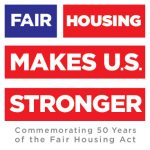Eliminating Racist (and Other Discriminatory) CC&Rs Creates Inclusive Communities

Ms. Zoe Ann Olson, Executive Director of the Intermountain Fair Housing Council, Inc.
Guest blog post by Zoe Ann Olson, Executive Director, Intermountain Fair Housing Council, Inc.
About a year ago, a homebuyer came into my office and showed me the Covenant, Conditions and Restrictions (CC&Rs—which restrict what homeowners can and can’t do with their property) for a home that he wished to purchase that was part of a homeowner’s association. He was shocked to see that one provision said, “No persons other than persons of the White race may reside on the property except domestic servants of the owner or tenant,” and wondered if he could still purchase the home or have his friends visit. I told him that the CC&R term was illegal and discriminatory, we helped address the language, and he purchased the home.
Real estate agents have also brought these discriminatory CC&Rs to Intermountain Fair Housing Council (IFHC) concerned about the discriminatory language and the effect it may have on the purchase or sale of a home. In this post, I am going to talk about IFHC and share best practices for addressing discriminatory CC&Rs.
IFHC is a nonprofit organization whose mission is to ensure open and inclusive housing for all people. The IFHC’s purpose is to advance equal access to housing for all persons without regard to race, color, sex, religion, national origin, familial status, gender identity, sexual orientation, source of income, or disability. The IFHC attempts to eradicate discrimination through education of the fair housing laws, housing information and referrals, housing counseling, and enforcement including filing complaints under the federal Fair Housing Act. To this end, community members, including real estate agents, contact us for help.
Before we discuss best practices for addressing discriminatory CC&Rs, it is important to understand how we ended up with them. Until the U.S. Supreme Court decision in Shelley v. Kraemer in 1948, which made such discriminatory language illegal, many subdivisions included racist language that denied people of color access to housing. In the early 19th century and through the 1950s, these CC&Rs were required by lenders and insurers participating federal loan programs and sometimes by city, county, or state law. These racist CC&Rs were also reinforced by homeowner’s associations (HOAs), agents, and other private entities in the transaction process, in order to maintain “all white” neighborhoods.
If you own a home in a subdivision that was created before or during the 1950s, you might want to take a look at the CC&Rs for this boilerplate language, as it was used throughout the Treasure Valley, Idaho, and the United States. While the federal Fair Housing Act outlawed such policies and practices, the lack of its enforcement means that little has been done to reverse the deeply embedded residential patterns of segregation.
With 2020 marking the 52nd Anniversary of the Fair Housing Act, it’s a great time to remind people of this issue and provide information on how to correct it. In addition to contacting IHFC for help, homeowners, potential buyers and sellers, and real estate agents can work together to address and eliminate discriminatory CC&Rs through the following best practices (not an exclusive list):
help, homeowners, potential buyers and sellers, and real estate agents can work together to address and eliminate discriminatory CC&Rs through the following best practices (not an exclusive list):
- Review the CC&Rs. If a discriminatory CC&R is identified, address it with the HOA board of directors, the HOA attorney, and/or an attorney who specializes in fair housing law… and if you’re a homeowner planning to sell your home, your real estate agent;
- Make sure your HOA attorney and the HOA board do not reaffirm the language;
- Follow your HOA rules for amending the CC&Rs, keeping in mind it may require a majority vote of the subdivision’s homeowners;
- If you can’t amend, adopt a resolution that the discriminatory provision is unenforceable. Make sure that every homeowner and the HOA have a copy of the resolution, and if the home is ever sold, that this resolution is provided to the buyers and all real estate agents involved in the transaction;
- If the home is sold before an amendment is made or a resolution is adopted, talk to the title companies involved in the transaction, and confirm their policy would insure them against violations of the Fair Housing Act;
- Check with Ada County Clerk’s Office about making changes to recorded documents;
- If you’re interested in learning more about this issue, read the Color of Law: A Forgotten History of How Our Government Segregated America by Richard Rothstein.
Engaging in best fair housing practices creates just housing for all, prevents most misunderstandings, and helps avoid fair housing violations. Owning a home in your neighborhood of choice is part of the American dream. Together, we can help make that a reality.
About the Author
Ms. Zoe Ann Olson has been the Executive Director of the Intermountain Fair Housing Council, Inc., for over five years. Ms. Olson has 14 years of experience as an attorney with Idaho Legal Aid Services, Inc., where she served as the Housing Specialty Chair and Fair Housing/Fair Lending Project Director. Ms. Olson has provided fair housing training for over 10 years and has been trained extensively on the issue of fair housing via John Marshall University, Seattle University, HUD, Accessibility First, National Consumer Law Center, National Fair Housing Alliance (NFHA), and AARP. She served on the Board of Directors for the Idaho Law Foundation, is a member of the Diversity Law, Real Property Law, Animal Law Sections, and Government and Public Law Sections of the Idaho State Bar, and Idaho Woman Lawyers. She is also a member of the Urban Land Institute, the Boise City/Ada County Coalition for the Homeless, NAACP, NFHA, and Girl Scouts.
For more information, contact Intermountain Fair Housing Council Executive Director Zoe Ann Olson at 1-208-383-0695 (extension 306), email her at zolson@ifhcidaho.org, or visit IHFC’s website at ifhcidaho.org.
Want to learn more about Fair Housing?
- Fair Housing Makes US Stronger
- Register for an upcoming Fair Housing class at BRR






